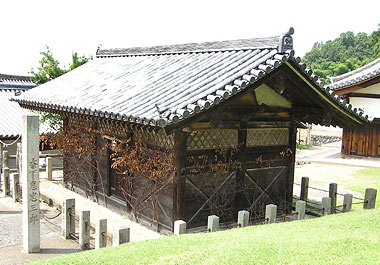|
||
 |
||

Toudaiji Nigatsudou Akaiya 東大寺二月堂閼伽井屋 (Nara)
(C)2001 Japanese Architecture and Art Net Users System. No reproduction or republication without written permission.
掲載のテキスト・写真・イラストなど、全てのコンテンツの無断複製・転載を禁じます。
|
||||||
| akaiya 閼伽井屋 | ||||||
| KEY WORD : architecture / buildings & structures | ||||||
| Also called wakasaiya 若狭井屋. A small structure that enclosed two wells from which water was drawn to serve the Buddha. The most famous Akaiya is at the Nigatsudou 二月堂 at Toudaiji 東大寺 in Nara. It is a simple 3 X 2 bay structure (6.64m X 3.63m) with half walls below, and diagonally set lattice in the upper half. The entrance has a swinging door. There are two wells inside the structure: a small one on the east side and a large one on the west side. The roof is gabled and tiled. The gable pediments contain large board frog-leg struts, ita-kaerumata 板蟇股. The posts are chamfered and the tie beams end in decorative nosings of *daibutsuyou 大仏様, a characteristic which suggests that this akaiya was erected in the Kamakura period. Other later examples are the akaiya of 1350 at Bujouji Kyuusuijo 峰定寺給水所 in Kyoto; the Momoyama period akaiya built in 1600 at Onjouji 園城寺 in Shiga prefecture; and the Edo period akaiya of the Shingon-in 真言院 of Toudaiji 東大寺 in Nara. | ||||||
 Toudaiji Nigatsudou Akaiya 東大寺二月堂閼伽井屋 (Nara)
|
||||||
| REFERENCES: | ||||||
| EXTERNAL LINKS: | ||||||
| NOTES: | ||||||
(C)2001 Japanese Architecture and Art Net Users System. No reproduction or republication without written permission. 掲載のテキスト・写真・イラストなど、全てのコンテンツの無断複製・転載を禁じます。 |
||||||